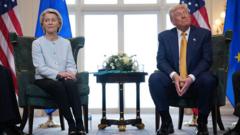The much-anticipated EU-US trade deal, celebrated last weekend as a diplomatic breakthrough, is overshadowed by mounting European discontent and unresolved complexities that may impede its effectiveness. Initially heralded as a successful resolution to avert the 30% tariffs threatened by former US President Trump, the new agreement stipulates a 15% tariff on most EU exports to the United States. This revised rate represents a significant increase from the previous average of 4.8%, prompting concern among various European states about the deal’s long-term implications.
Following the announcement, criticism has grown aimed at European Commission President Ursula von der Leyen. While some officials acknowledge the agreement's ability to provide short-term clarity and stability for European businesses, many worry the decision lacks a robust negotiating approach. "I would have wished for a different outcome," remarked Germany's finance minister Lars Klingbeil, weighing the deal as a double-edged sword—recognizing the importance of avoiding further escalation while lamenting the consequences of new tariffs.
As of this week, no legally binding agreements had been finalized, with officials from both sides indicating that the pact's political commitments still required extensive negotiation. In contrast, the US administration has characterized the agreement as groundbreaking, with US Commerce Secretary Howard Lutnick stating that further discussions on the deal's framework will continue.
French President Emmanuel Macron termed the agreement a "first step" in an extended negotiation process, during which trade experts anticipate adjustments to the proposed tariffs might materialize. Tariffs on various sectors remain ambiguous, particularly regarding pharmaceuticals and semiconductors, as the US claims these products will incur new tariffs while the EU insists they will maintain a zero-rate temporarily.
The disparities highlighted by the two parties extend to significant allocations, with differing interpretations of investment commitments. For instance, while the US asserts that the EU is committed to purchasing large quantities of American energy products, EU officials merely hint at intentions for future purchases contingent on market conditions and private sector interests.
Notably, the automotive sector, particularly in Germany, faces significant financial implications due to its reliance on exports to the US, with industry leaders warning of multiple billions in new costs. Similarly, Ireland's economy, heavily dependent on pharmaceutical sales to the US, grapples with a precarious position under the current agreement.
While some European countries may manage to mitigate effects of the tariff increase, nations like Italy are experiencing pronounced risks, including a projected GDP downturn due to heightened trade tariffs. Political responses in Italy reflect a growing sentiment of dissatisfaction, with calls for EU compensation arising from trade associations concerned about the deal's economic ramifications.
Cinzia Alcidi, of the Centre for European Policy Studies, warns against blanket compensation measures, arguing that direct subsidies would merely fulfil Trump’s vision by placing the tariff burden on European taxpayers. As the new trade agreement enters its nascent phases while still steeped in negotiation, European leaders are urged to find a balance between further commitments to the US and safeguarding their own economic interests.






















